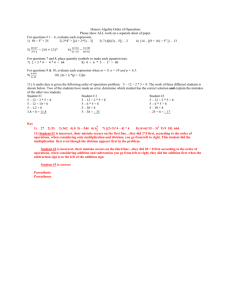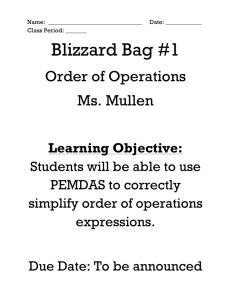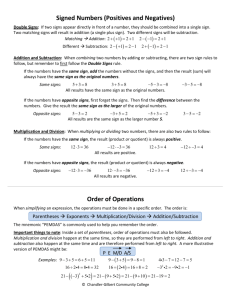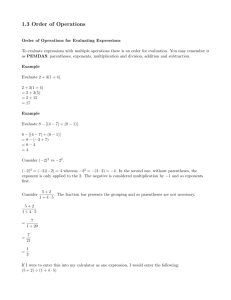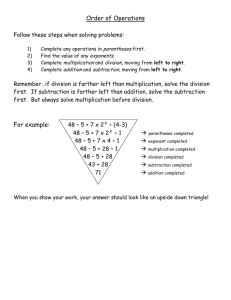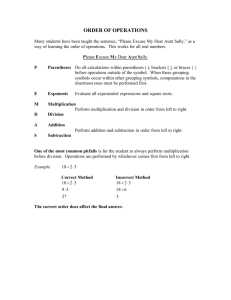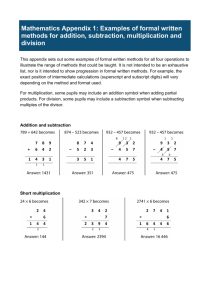2.4 Order of Operations Involving Negative Numbers
advertisement
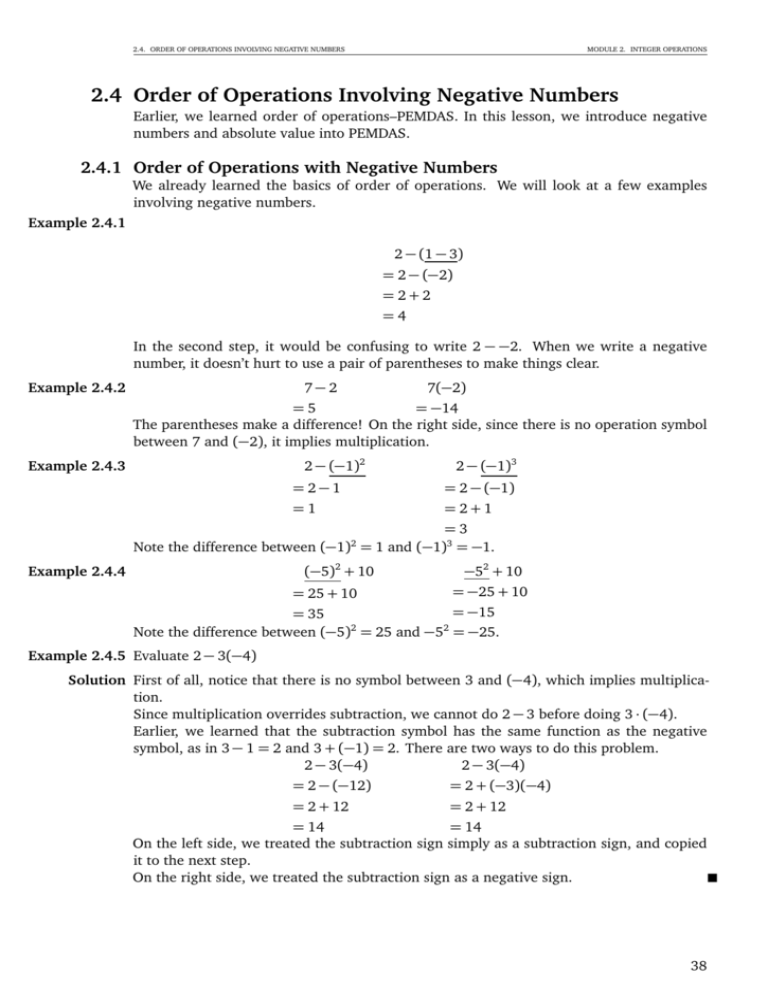
2.4. ORDER OF OPERATIONS INVOLVING NEGATIVE NUMBERS MODULE 2. INTEGER OPERATIONS 2.4 Order of Operations Involving Negative Numbers Earlier, we learned order of operations–PEMDAS. In this lesson, we introduce negative numbers and absolute value into PEMDAS. 2.4.1 Order of Operations with Negative Numbers We already learned the basics of order of operations. We will look at a few examples involving negative numbers. Example 2.4.1 2 − (1 − 3) = 2 − (−2) =2+2 =4 In the second step, it would be confusing to write 2 − −2. When we write a negative number, it doesn’t hurt to use a pair of parentheses to make things clear. 7−2 Example 2.4.2 7(−2) =5 = −14 The parentheses make a difference! On the right side, since there is no operation symbol between 7 and (−2), it implies multiplication. 2 − (−1)2 Example 2.4.3 2 − (−1)3 =2−1 = 2 − (−1) =1 =2+1 =3 Note the difference between (−1)2 = 1 and (−1)3 = −1. (−5)2 + 10 Example 2.4.4 = 25 + 10 −52 + 10 = −25 + 10 = −15 = 35 2 2 Note the difference between (−5) = 25 and −5 = −25. Example 2.4.5 Evaluate 2 − 3(−4) Solution First of all, notice that there is no symbol between 3 and (−4), which implies multiplication. Since multiplication overrides subtraction, we cannot do 2 − 3 before doing 3 · (−4). Earlier, we learned that the subtraction symbol has the same function as the negative symbol, as in 3 − 1 = 2 and 3 + (−1) = 2. There are two ways to do this problem. 2 − 3(−4) 2 − 3(−4) = 2 − (−12) = 2 + (−3)(−4) = 2 + 12 = 2 + 12 = 14 = 14 On the left side, we treated the subtraction sign simply as a subtraction sign, and copied it to the next step. On the right side, we treated the subtraction sign as a negative sign. 38 2.4. ORDER OF OPERATIONS INVOLVING NEGATIVE NUMBERS MODULE 2. INTEGER OPERATIONS 2.4.2 Order of Operations involving Absolute Value We need to modify the acronym PEMDAS to include absolute values: P (Parentheses and Absolute Value) E (Exponent) MD (Multiplication and Division) (Addition and Subtraction) AS FIGURE 2.10: Order of Operations Basically, the absolute value symbols have the same priority as parentheses, except it changes negative numbers to positive. Let’s look at a few examples. Example 2.4.6 3 − (1 − 4) 3 − |1 − 4| = 3 − | − 3| = 3 − (−3) =3−3 =3+3 =6 =0 Note the difference between |1 − 4| = 3 and (1 − 4) = −3. It’s common mistake to change |1 − 4| to |1 + 4|. We must complete all operations inside the absolute value symbols before changing the number inside to positive. Example 2.4.7 3 − 2|4 − 1| = 3 − 2|3| = 3 − 2(3) =3−6 = −3 It’s a common mistake to do 3 − 2 first. Notice the implied multiplication between 2 and |4 − 1|. We must do multiplication before doing subtraction. Also, from 2|3| to 2(3), notice we added a pair of parentheses around 3. Otherwise, we must add a dot, 2 · 3, to make it clear the operation is multiplication. We just cannot write 23. 1 − 3 |1 − 3| Example 2.4.8 −1 −1 | − 2| −2 = = −1 −1 2 = = |2| −1 =2 = −2 Note that the length of the absolute value symbols make a difference! 39
